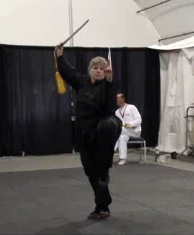
Internal styles of Chinese Martial Arts focus primarily on internal aspects more than external brute force. Elements such as qi (breath, intrinsic energy, blood or energy flow have been used to define qi), spirit, mind, and the practice of using the least amount of effort to achieve an ends are emphasized. Some people have referred to the internal style practitioners as lazy because the disciplines lack flash, speed, and power. However, I prefer to believe that there is a greater understanding of body mechanics and body efficiency.
Wikipedia contains a nice excerpt about the definition of Internal Styles:
“Components of internal training includes stance training (zhan zhuang), stretching and strengthening of muscles, as well as on empty hand and weapon forms which can contain quite demanding coordination from posture to posture.[20] Many internal styles have basic two-person training, such as pushing hands. A prominent characteristic of internal styles is that the forms are generally performed at a slow pace. This is thought to improve coordination and balance by increasing the work load, and to require the student to pay minute attention to their whole body and its weight as they perform a technique. In some styles, for example in Chen style of taijiquan, there are forms that include sudden outbursts of explosive movements. At an advanced level, and in actual fighting, internal styles are performed quickly, but the goal is to learn to involve the entire body in every motion, to stay relaxed, with deep, controlled breathing, and to coordinate the motions of the body and the breathing accurately according to the dictates of the forms while maintaining perfect balance.”
Internal Styles include three main families: Taichi (Taiji), Bagua, & Xing Yi. Within the Taichi family, there are five distinct styles named after the family of origin: Chen, Yang, Wu Hao, Wu and Sun.
Here is a demonstration of Wu Style Taichi performed by Gene Jaress:





